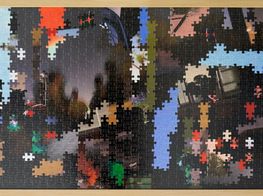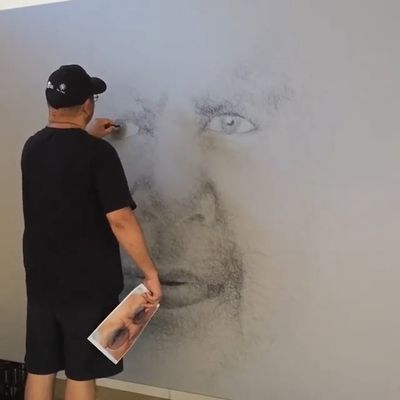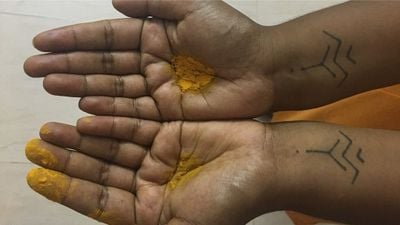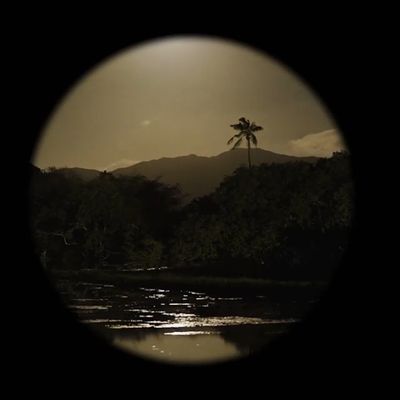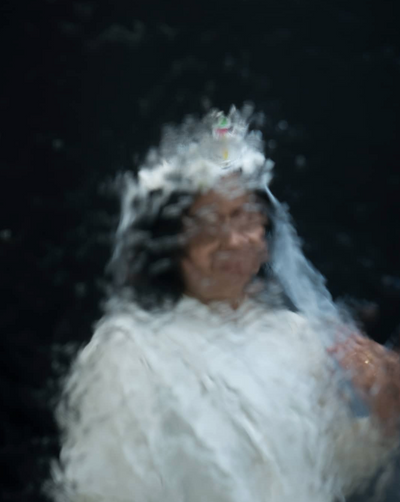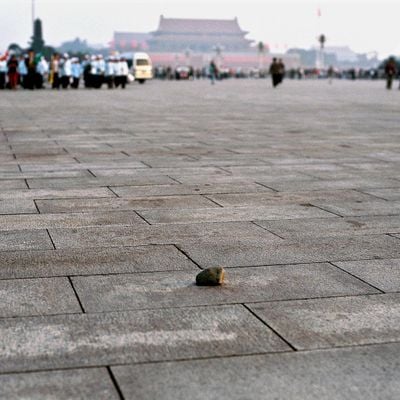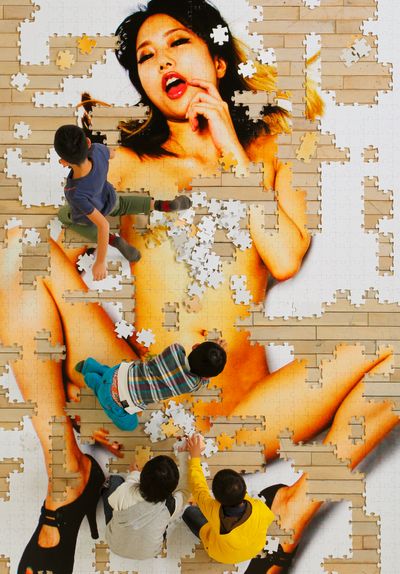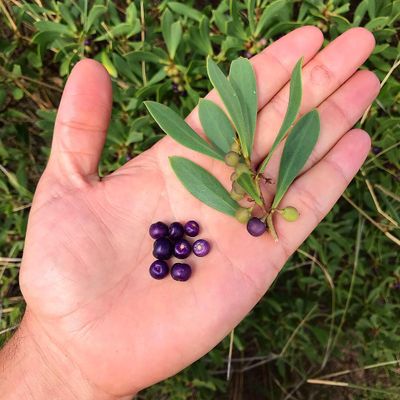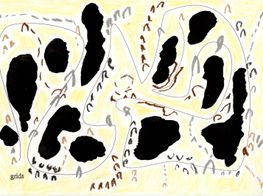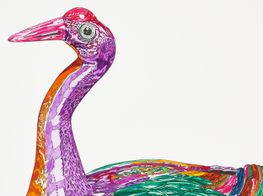Dismantle the Map: As Demonstrated by 52 Artists and their Actions
In Collaboration with Artspace Sydney
This essay appears in 52 Artists 52 Actions: Small Acts of Disobedience, co-published by Artspace Sydney and Thames & Hudson Australia in 2019. It is now exclusively published online with Ocula in collaboration with Artspace Sydney. The publication is available to purchase from here.
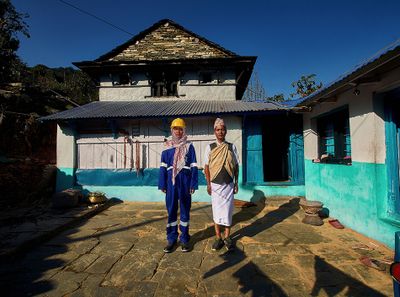
Hit Man Gurung, The Revolutionary Dreams (2018). Performative photography, from the ongoing series 'I Have to Feed Myself, My Family and My Country' (2015–). Instagram post for 52 ARTISTS 52 ACTIONS (1 March 2018). Courtesy the artist and Artspace, Sydney. Photo: Sachin Yogal Shrestha.
As part of his Instagram intervention for 52 ARTISTS 52 ACTIONS, Jason Wee presents poetry that departs from a residency he undertook on an oil tanker, which imagines 'a voyage on a ship that sailed away from a rapidly changed and changing continent ... an Asia reshaped by new infrastructure systems, precarious labour, climate crises, and states gathering authoritarian force'. Wee describes his verses as a collection of letters to 'this present future'; as 'postcards to surviving readers' who inhabit a transformed geography.
The same could be said of 52 ARTISTS 52 ACTIONS as a whole: a polyphonic letter to the future in which space is not bound to territory as much as it is to time and the earthly bodies that mediate its passage. Take The Mulka Project, a Yolŋu-managed production house and archive based in north-east Arnhem Land in Australia, whose mission is expressed in a series of posts: 'To bring knowledge from the past to the present, and from the present to the future' through the creation and dissemination of 'a growing, living archive of Yolŋu knowledge, ceremony and cultural history'. Or consider Bhenji Ra's snapshots into a community 'of trans, queer and non-binary people of colour belonging to the Asia Pacific diaspora', who seek survival 'within the spaces that attempt to threaten and constrain' them, while decentring those spaces in turn. In the case of Tromarama, the collective performs a forecasting of the future using their own software that gathers tweets connected with a time-related hashtag on Twitter, reformatting them into poetic text, with one line in a series of slides reading: 'I am a time traveller.'
History runs in the blood in Vernon Ah Kee's moving images documenting the creation of his father's portrait after his death, as it does in Tuấn Andrew Nguyễn's film excerpts, which map the legacy of French colonialism in Vietnam by way of West Africa. As Nguyen explains, West African soldiers who fought for the French during the Second World War also fought in Vietnam during the Anti-French Resistance War (between 1946 and 1954), with a significant number of Vietnamese women and children migrating to Senegal after France's defeat, resulting in generations who carry their genes and memories. Familial connection as a mode of historical transmission is evident, too, in Khet: videos of Shivanjani Lal performing Pranama, a Hindu form of salutation addressed to something or someone, often ancestors. Captions give insight into Lal's personal history, which moves from India and Fiji to Australia. In one note addressed to her Nanni, Lal writes: 'This is for the time you crossed the Kala Pani twice 1938–1940' – Kali Pani referring to the offence of crossing the ocean, or 'black waters', to foreign places and thus creating a disconnect with Hindu traditions and ways of life that are bound to the land. 'What did you do?' Lal continues, '... were you lost like I am now?'
Being lost and feeling loss are common experiences for post-colonial and diasporic bodies (be they mixed or otherwise), and for those whose dislocation is recent. Among the past projects that Rushdi Anwar presents for his Instagram slot are clips of the single-channel video Facing Living: The Past in the Present, 2015, which focuses on a pair of hands tearing up and re-piecing a portrait of Saddam Hussain – a loaded gesture given the artist's Kurdish background and the dictator's persecution (and 1988 genocide) of Iraqi Kurds. Anwar's engagement in Brook Andrew's project What's Left Behind, 2018, offers a contextual backdrop to the present state of Iraq, starting with the partitioning of the Ottoman Empire by colonial forces following the First World War, which denied the Kurds – now among the largest stateless nations in the world – a state of their own. Anwar also presents scenes from The Notion of Place and Displacement, 2017, a seven-channel video installation documenting life in the Arbat Refugee Camp in Kurdistan. The artist's aim is 'to draw attention to the commonality of displacement' – a commonality that Nasim Nasr encapsulates in one slide listing seemingly innocuous questions about home, such as 'Where do you come from?', which emphasise the anxiety of not quite having one, or being far from it. The Refugee Art Project, presenting art created in workshops with asylum seekers and refugees now living in Western Sydney, highlights another anxiety-inducing question. Images by Sara M from Iran depict a woman on a magic carpet, another holding red balloons flying in the sky, and a third sitting on a blue whale, each scene accompanied by the words 'How did you come to Australia?' In another illustration by Mona Moradveisi a woman's hair turns into watery waves, below which a caption reads, 'The ocean is my passport'.
The fluidity of identity is reflected in Tintin Wulia's ongoing work The Passport Chain.[1] The piece incorporates related projects such as the continuing performance-workshop Make Your Own Passport and (Re)collections of Togetherness, which has seen the artist collect and replicate the world's passports since 2007. She describes (Re)collections of Togetherness as a never-ending project that intends to trace 'the geopolitical movements of borders on the earth', which mirrors the testimonies of movement and displacement that 52 ARTISTS 52 ACTIONS tracks.
Shiraz Bayjoo's accounts of marginalised histories include a pair of videos about Mauritius as a shelter for runaway slaves in the 18th and 19th centuries, which is how Sega, a musical form that was developed in slave camps, eventually became the island's main musical tradition. While Mike Parr's project, Not the Hilton, traces connections across temporalities, pairing excerpts from the 2000 Immigration Detention Centre Inspection Report issued by the Australian Government with a reverse recording of Beethoven's Für Elise – a reference to a Nazi concentration camp commandant who apparently found relief from his gory work in Beethoven's music.
Samson Young focuses on a figure that exemplifies how histories of global movement shape real bodies, be they individual or collective, in ways that make incongruity inescapable. Early 20th century letters from community leader and public servant Alexander Won Cumyow, the first Canadian-born Chinese and representative of the Chinese Empire Reform Association, are addressed to Queen Victoria and Edwin Hurd Conger, US Minister to China, and request support for Emperor Guangxu during the Boxer Rebellion. Yet Cumyow was a contradictory figure. As Janet Mary Nicol writes, 'He campaigned for a democratic China but never visited – or desired to visit – the land of his ancestors', and 'though he advocated for Chinese-Canadians, the majority of whom lived within the confines of Chinatown, he chose to live away from the area'.[2]
The condition of dislocation – and the hybrid identities that are produced as a result – results in a kind of embodied ambiguity: a contradictory position that lends itself to the frame in which 52 ARTISTS 52 ACTIONS unfolds online. Instagram is a space that Reetu Sattar directly references in the introduction to Queen of Hearts, a series of portraits of the artist's mother either completely or partially obscured. Sattar tallies the roughly 800 million people – and counting – who engage with the social networking site, and the composed selfies of influencers and their emulators that circulate it. The politics of attention in this context – reliant on the performing body and the willing eyes of an audience – offers a fitting frame for Sawangwongse Yawnghwe's intervention, Office in Exile/Special Rapporteur. This series of posts protests military abuses in Myanmar, including the violence against the Rohingya, and demonstrates the artist's burden of having to bear witness from afar. The problematic act of looking in from the outside in order to comment, reflect and critique is often aligned with a colonialist gaze, but Yawnghwe uses this position to reroute attention; just as Pio Abad utilises his Instagram takeover to protest the rehabilitation of dictator Ferdinand Marcos by Philippines president Rodrigo Duterte.
Throughout, 52 ARTISTS 52 ACTIONS embraces or amplifies contradictions in order to uncover, problematise, challenge and ultimately transcend histories of trauma and violence that continue to shape the present. In some cases, accounts complicate the perception of colonialism as a fight for freedom, or as a historical binary between East and West. Nicolas Molé's crash course on New Caledonia's history, posted in the lead-up to the 2018 referendum that would decide whether the territory would continue with French colonisation or seek independence, was followed by the decision to remain a colonised territory. While Chia-En Jao's archival photos of Indigenous peoples from Ainu and Taiwan displayed at the imperialist Japan–British Exhibition in 1910 explore another colonial arc. These photos are accompanied by Morse code recordings, apparently listing survivors of the Mudan Incident at Padriyiur Bay in 1871, when Paiwan aborigines (reportedly as a result of a misunderstanding) killed 54 sailors from the Ryukyu Islands who were shipwrecked on Taiwan, prompting retaliation from the Japanese imperial army and paving the way for the cession of Taiwan to Japan after China's defeat in the First Sino-Japanese War.
Meanwhile, Ritu Sarin and Tenzing Sonam explore a present-day manifestation of colonial and anti-colonial action in their stand against the 'dismantling of the Tibetan language and identity currently taking place in Tibet' by China. For their action they focus on the case of Tashi Wangchuk, a shopkeeper imprisoned for five years by Chinese authorities under the charge of inciting separatism. His crime was to travel to Beijing to plead for the protection of Tibetan language and culture by invoking the Chinese Constitution, which is meant to protect language rights for minorities.
Histories overlap and expand as they are folded into the present, and trajectories are brought into a complex and unrelenting cross-hatching view. This overlapping is reflected in Zhao Zhao's approach to Xinjiang and Beijing: two places where massive and contrasting transformation has unfolded. Reflecting on projects from the past ten years, the artist presents images from Project Taklamakan, which involved transporting a beer-filled refrigerator and 100-kilometre, 4-core cable from Beijing to the centre of the Taklamakan desert, and the installation of a Bactrian camel in a Beijing gallery. As Zhao Zhao writes, 'Every being – be it human or animals – is subject to geopolitics, and every element is deeply intertwined.' Here, the idea of Asia can be read in the same way, taking into account the manner in which Abdul Halik Azeez describes Sri Lanka as 'a rich semiotic landscape where signs and symbols converge into constellations of meaning, often speaking to our unconscious'.
Such constellations of meaning are located in the artist's body in Hit Man Gurung's contribution, The Revolutionary Dreams. These images stem from his ongoing performative photography series, I Have to Feed Myself, My Family, and My Country, and in each Gurung stands facing the camera in the Nepalese village where he grew up, dressed as characters he recalls from his past, such as a Maoist revolutionary fighter. Besides each of these figures, Gurung adds another shot of himself in the blue uniform of a migrant worker: a reference to the thousands of Nepalis who leave the country every year seeking employment, many of whom end up in the Gulf States and Malaysia. The artist describes his project as an exploration into how the social fabric of a developing country such as Nepal has been shaped by internal and external conflict, instability and global capitalist forces. In short, it is an embodied and aesthetic reaction to multifaceted and continuously developing geopolitics that have shaped and continue to shape Asia and the world at large.
The Revolutionary Dreams points to another thread that runs through 52 ARTISTS 52 ACTIONS: the idea that modernisation's effects on physical landscapes – another form of displacement – mirrors the legacies and impacts of colonialism. Tokyo-based artist collective ChimPom give their Instagram slot to the only female member, Ellie, who introduces a 'city undergoing rapid "scrap & build" redevelopment towards the 2020 Olympics', in a country still haunted by the 2011 tsunami and the Fukushima nuclear disaster; while Rasel Chowdhury's photos reacting to the loss of public space in Dhaka caused by a growing population include a blue-sky square documenting a rare clean-air day and a protest against the Rampal coal power plant construction. Tita Salina and Irwan Ahmett's ongoing project Pilgrim to the North (Ziarah Utara) charts a ten-day walk along North Jakarta's coastline undertaken to measure rising sea levels, while collecting stories from communities directly affected by such developments. In all these projects, the environment seems to surpass historical divides, with artists locating a violent division between humans and nature instead. As Art Labor Collective states in an action rooted in 'the toughest drought in the Central Highlands of Vietnam':
'We killed the soil. We killed the water.
The soil and water uprose.'
With that in mind, it is fitting that 52 ARTISTS 52 ACTIONS ends with a grounded solution to a common problem – an introduction to Indigenous cultural environmentalism by James Tylor, who demonstrates, among other tactics, 're-wilding urban streetscapes and domestic gardens in the city', and 'collecting and cooking with indigenous food plants from the Kaurna region'.
It is fitting that the first action to kick everything off was Richard Bell's celebration of Australia's first Nobel Peace Prize winners, the International Campaign to Abolish Nuclear Weapons (ICAN), who were awarded in 2017; and Bell's criticism of Prime Minister Malcolm Turnbull's failure to congratulate them, as well as Australia's failure to sign the nuclear disarmament treaty.
Bell presents a series of images charting the impact of nuclear history, from the haunting photograph of a girl's shadow imprinted on a wall as a result of the bomb being dropped on Hiroshima in 1945, to an image of the One Tree Explosion at Maralinga in 1956 – one of seven nuclear bomb blasts carried out in the South Australian desert by the British – and a shot of Chernobyl captioned with a sobering reminder that there have been some 28 nuclear accidents since 1957. All of which recalls Professor Andy Stirling's observation that: 'Half a century ago, the worldwide rise of nuclear power provided a leitmotif for post-war Modernity ... But more recent drastic relative decline in global nuclear fortunes offer an equally iconic disruption of this story'.[3] In the 21st century, it is becoming increasingly clear that the problems caused by historical 'progress' – from environmental devastation, conflict and colonialism, to the effects of capitalism – are no longer regional, but inherently global. This leaves us with one truth, which Hera Büyüktaşçıyan displays in the image of a 1661 plate discovered in a London sewer, on which a simple phrase is written: 'You & i are Earth.'
Here, the Pacific concept of Talanoa, introduced by Lal in the context of 52 ARTISTS 52 ACTIONS, offers a way of honouring this shared reality: a word that seeks to surpass difference through 'a process of inclusive, participatory and transparent dialogue', that builds empathy and seeks out 'wise decisions for the collective good'.[4] One place to start, as suggested by Rosanna Raymond's citing of Lana Lopesi's 2018 publication asking how we might get to know each other again, False Divides, is to dismantle the maps that define the world as a place of division.—[O]

